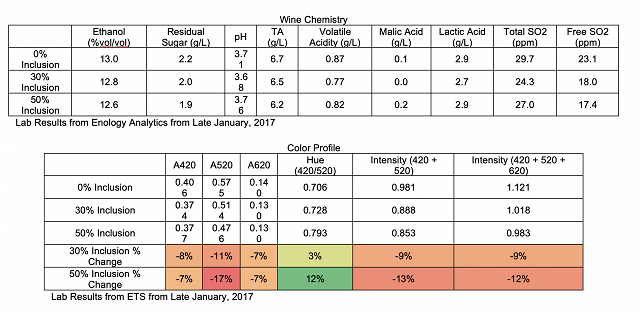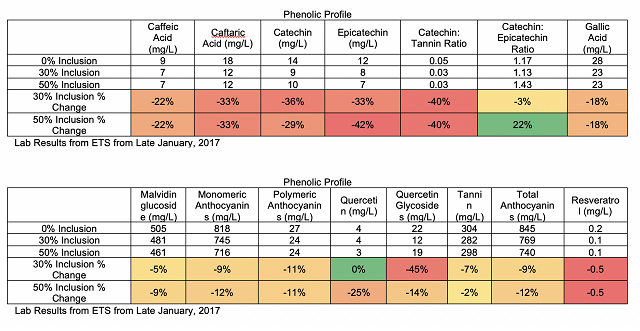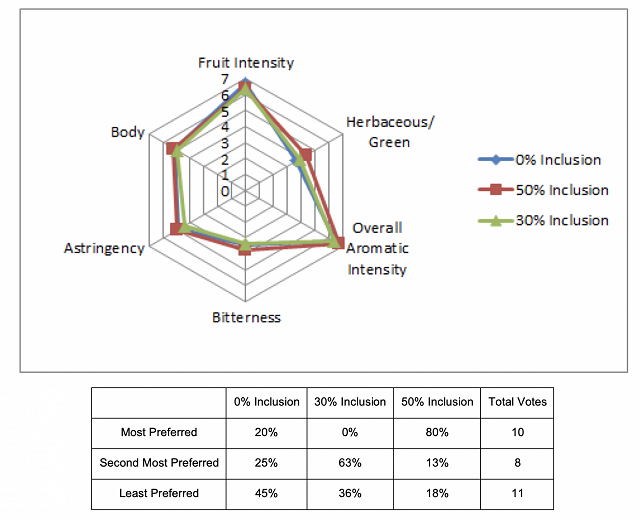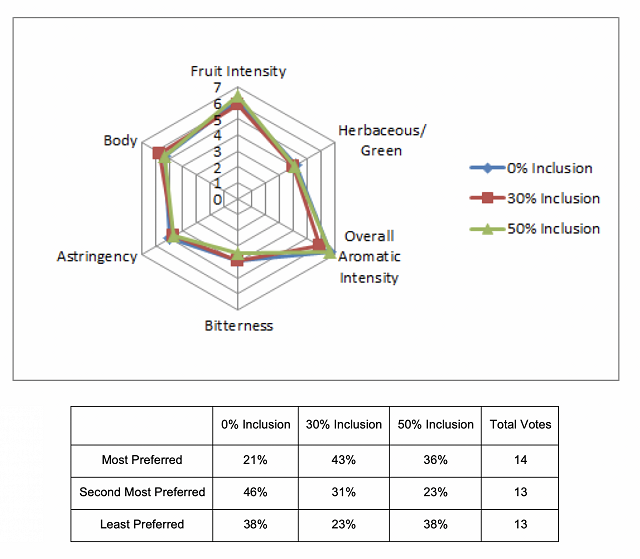Whole Cluster Inclusion in Chambourcin Fermentations (2016)
Lee Hartman
Bluestone Vineyards
Summary
This study examines the impact of whole cluster inclusion on the phenolic and sensory characteristics of Chambourcin wines. Chambourcin grapes sourced from the same block were either completely destemmed and lightly crushed (0% inclusion), 70% were destemmed and lightly crushed (30% inclusion), or 50% were destemmed and lightly crushed (50% inclusion). All other treatments between lots were the same. Increasing the amount of whole cluster inclusion tended to lower the ethanol content. Whole cluster inclusion tended to lower the color intensity and increase the hue, and this effect was more pronounced for higher levels of inclusion. All phenolic indices were lowered by whole cluster inclusion, but did not differ much between 30% and 50% inclusion. This was most noticeable with monomeric and total anthocyanins, as well as malvidin glucoside. Overall, whole cluster inclusion tended to increase Herbaceous/Green character in the wines. Descriptions of these wines were mixed, and most trends were weak and varied from tasting to tasting. No major preference trends could be seen across tastings. This study suggests that whole cluster inclusion could be a viable stylistic tool for Chambourcin wines, but much more work is needed to elucidate what impacts these kinds of treatments have on wine quality.
Introduction
The role of whole cluster and stem inclusion in winemaking is very controversial. Whole cluster fermentation is often used in Burgundian Pinot noir and is thought to add complexity to the wine (Weston 2000). Whole clusters are thought to round out and complement the low tannin in Pinot noir, and the flavors of Syrah can be complemented by stems (Meisner 2016). However, whole cluster inclusion also results in stems being added to the wine. Stems can enhance structure and wine quality sometimes, but also can add vegetal aromas (Ribèreau-Gayon et al. 2006). In certain cases, these vegetal aromas can also be perceived as spicy, and may act as a counterbalance to overly fruity qualities. Vegetal aromas and tannin additions may also balance out some carbonic maceration character which is found in whole cluster inclusion, which enhances ester aromatics, extends fermentation after pressing, and reduces the contribution of seed tannin. Stem inclusion is less common for Bordeaux varieties because of their already high levels of pyrazine (Meisner 2016). The reticence to use stems due to pyrazine characteristics in certain varieties is likely unfounded, due to cultural practices and climatic conditions which can greatly lower pyrazine character. Stems tend to lower alcohol content, decrease titratable acidity, and increase pH (due to high potassium levels). Stems can contribute a large amount of tannin to wine. Additionally, stems tend to decrease color intensity by adsorbing anthocyanins (Ribèreau-Gayon et al. 2006; Reshef et al. 2016). Finally, wines made with stem inclusion tend to have higher color stability over time (Ribèreau-Gayon et al. 2006). These results vary, however (Ribèreau-Gayon et al. 2006), and are dependent on many other factors, such as extraction kinetics, maceration practices, the level of crushing in the grapes, grape variety, and possibly stem maturity. Whole cluster and stem inclusion require much more thorough study before any hard conclusions can be drawn. This study examines the impact of whole cluster inclusion on Chambourcin wine.
Results and Discussion
Increasing the amount of whole cluster inclusion tended to lower the ethanol content. Whole cluster inclusion tended to lower the color intensity and increase the hue, and this effect was more pronounced for higher levels of inclusion. All phenolic indices were lowered by whole cluster inclusion, but did not differ much between 30% and 50% inclusion. This was most noticeable with monomeric and total anthocyanins, as well as malvidin glucoside. These results seem to be a mix of some classical results that can be seen in either stem inclusion wines or carbonic maceration wines (lower TA, ethanol, and color).


For descriptive analysis on the May 3 tasting, there were no strong trends for the descriptors used in this study. There were slight tendencies for the 50% inclusion wine to have higher Body, Herbaceous/Green qualities, and Astringency. In general, there was a preference for the wine with 50% whole cluster inclusion. 30% inclusion was the second-most preferred, and 0% inclusion was generally least preferred. These preferences were based on a small number of votes, however.

No major trends were found with the descriptors used in this study on the May 24 tasting. There was a weak tendency for the 30% inclusion to increase Herbaceous/Green character. Whole Cluster Inclusion slightly increased Bitterness. There was a slight trend to prefer no whole cluster inclusion, although 30% inclusion was also generally received well. The 50% inclusion wine was generally the least preferred.

For the May 31 tasting, there was a strong trend for the 0% inclusion to be more Astringent than the 30% and 50% inclusion wines. 0% and 50% inclusion had a weak tendency to have higher Overall Aromatic Intensity, and 50% inclusion tended to have lower Bitterness. No strong preference trends could be seen.

Overall, whole cluster inclusion tended to increase Herbaceous/Green character in the wines. Descriptions of these wines were mixed, and most trends were weak and varied from tasting to tasting. No major preference trends could be seen across tastings. This study suggests that whole cluster inclusion could be a viable stylistic tool for Chambourcin wines, but much more work is needed to elucidate what impacts these kinds of treatments have on wine quality.
Methods
Chambourcin grapes sourced from the same block were hand-picked on the same day and processed as follows:
- 100% destemmed, lightly crushed
- 30% whole cluster, 70% destemmed and lightly crushed
- 50% whole cluster, 50% destemmed and lightly crushed
No sulfur dioxide was added. The total weight of grapes used between treatments was the same. Every bin received 100mL ColorPro per ton during crush and were inoculated with RC212 at 20g/hL (rehydrated with 15g/hL GoFerm) on the day of processing. Punch downs were twice per day throughout fermentation. During fermentation 1kg/hL sugar was added and 1g/L tartaric acid was added. The wine was drained and pressed after two weeks, and free run and press fraction wines were blended together. After the wine had settled for 24 hours it was racked into separate neutral barrels, where malolactic conversion occurred.
This project was tasted on May 3, May 24, and May 31. In order to balance the data set to perform statistical analysis for descriptive analysis on the May 3 tasting, any judge who had not fully completed the descriptive analysis ratings were removed. In order to then make the number of judges between groups equivalent, one judge from group 1 and group 2 were eliminated. This resulted in a final data set of 3 groups, each with 3 judges (considered as replications within groups, and groups were considered as assessors). Data was analyzed using Panel Check V1.4.2. Because this is not a truly statistical set-up, any results which are found to be statistically significant (p<0.05) will be denoted as a “strong trend” or a “strong tendency,” as opposed to general trends or tendencies. The statistical significance here will ignore any other significant effects or interactions which may confound the results (such as a statistically significant interaction of Judge x Wine confounding a significant result from Wine alone). The descriptors used in this study were Fruit Intensity, Herbaceous/Green, Overall Aromatic Intensity, Bitterness, Astringency, and Body.
The same procedures for data analysis were used on the May 24 tasting. For the descriptive analysis in this tasting, in order to balance the data set one judge from group 3 was transferred to group 1. This resulted in a final data set where each group had five judges, for a total of 15 judges.
The same procedures for data analysis were used on the May 31 tasting. For the descriptive analysis in this tasting, one group was eliminated from group 1 and group 3 so that each group had three judges, for a total of 9 judges.
References
Meisner, M. 2016. Fermentation 101: The case for whole clusters. Last Bottle. http://blog.lastbottlewines.com/education/whole-clusters/. Accessed 2/10/2017.
Reshef, N., Morata, A., and Suárez-Lepe, J.A. 2016. Towards the use of grapevine by-products for reducing the alcohol content of wines. Biointerface Research in applied Chemistry. 6:1531-1537.
Ribèreau-Gayon, P., Dubourdieu, D., Donèche, B., and Lonvaud, A. 2006. Handbook of Enology, Volume 1: The Microbiology of Wine and Vinifications 2nd Edition. John Wiley & Sons. Chichester, West Sussex, England.
Weston, L.A. 2000. Grape and wine tannins and phenolics – their roles in flavor, quality and human health. 29thAnnual New York Wine Industry Workshop. https://ecommons.cornell.edu/handle/1813/39812. Accessed 2/7/2017.
